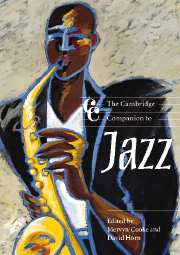Book contents
13 - Learning jazz, teaching jazz
from Part Four - Jazz soundings
Published online by Cambridge University Press: 28 September 2011
Summary
Not everyone has subscribed to the idea that all people can learn to play jazz. Since the time of the earliest accounts of the music, many writers and audiences have perceived jazz as a ‘natural expression’ of the performers rather than as a learned and practised behaviour. This perception has taken two predominant modes: that the ability to play jazz passes mysteriously from some invisible source through select ‘great’ individuals (i.e., geniuses), or that jazz springs forth from a subconscious and unmediated ‘voice of the people’, more specifically, an apparently unified African-American population. Prevalent as these notions have been, however, neither of them explains certain fundamental aspects of musical performance, and this chapter will focus on some of the ways in which jazz musicians have acquired and handed down to others the practical knowledge of their craft. It will investigate both the informal venues in which individuals learn how to play jazz and, in somewhat greater depth, some of the methods, values and influences of the relatively recent institutionalisation of jazz pedagogy, commonly referred to now as ‘jazz education’. But before turning to these issues, it may be helpful to review briefly the attitudes and beliefs behind the aforementioned ‘natural expression’ perceptions.
‘Some folks got it and some folks ain't’
Public notions of jazz as the product of either biology or genius are rooted in a number of historical and cultural domains. First, white audiences and critics around the turn of the twentieth century had come to understand music largely as a notated phenomenon, the craft of improvisation in European-based styles having gradually died out over the course of the previous decades. Consequently, these listeners marvelled at the ability of jazz musicians to vary, embellish and invent melodic lines, seemingly effortlessly and ‘out of thin air’ (see, for example, Ansermet 1919).
- Type
- Chapter
- Information
- The Cambridge Companion to Jazz , pp. 253 - 269Publisher: Cambridge University PressPrint publication year: 2003
- 3
- Cited by



